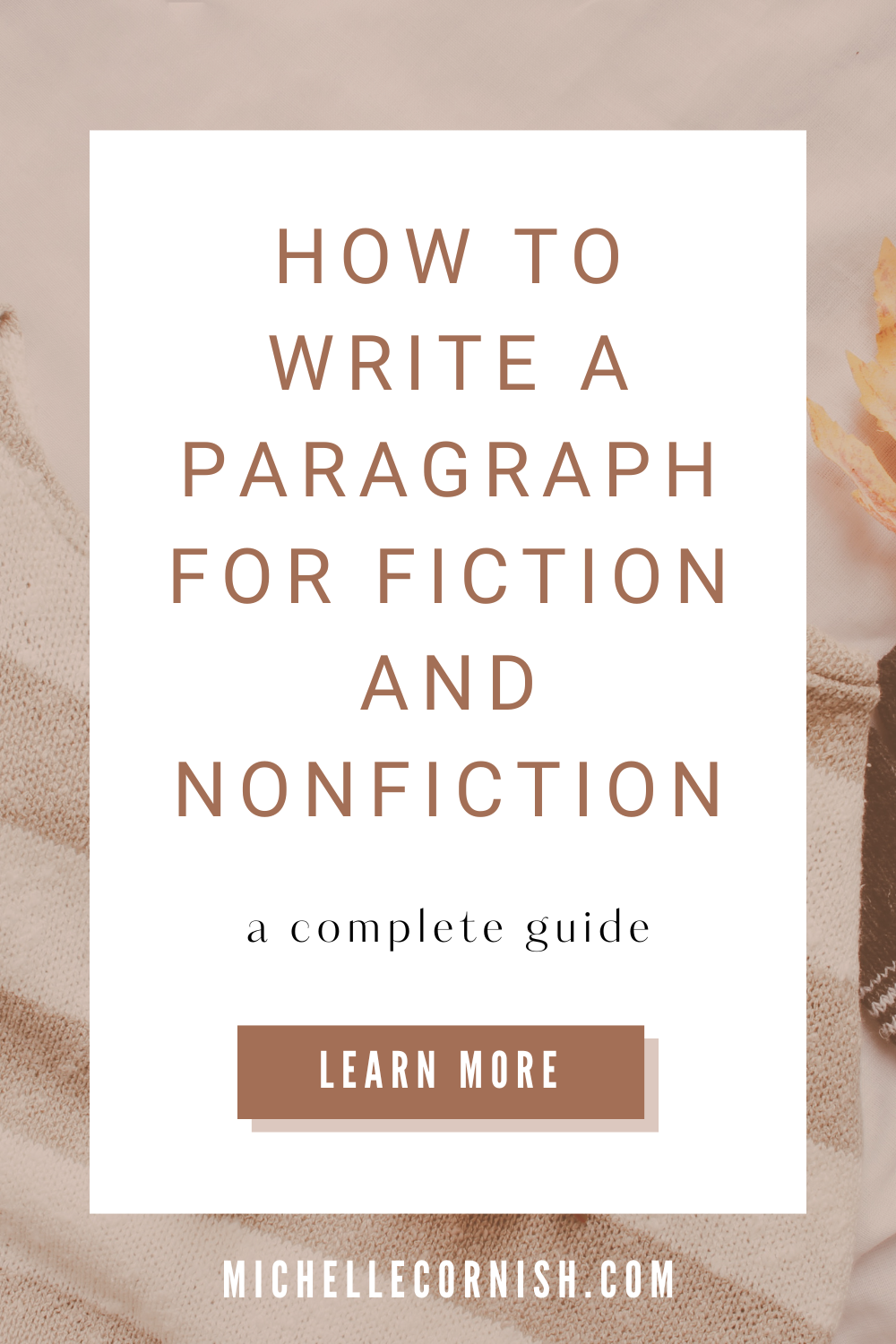How to Write Paragraphs for Fiction and Nonfiction: A Complete Guide
/Paragraphs are easy to overlook when we talk about the writing process. We focus on plot, voice, structure, or argument. But strong paragraphs are what keep readers turning the page—or scrolling to the next section.
Whether you're writing a blog post, a personal essay, a novel, or anything in between, your paragraphs shape the way your words land. They're more than just blocks of text—they're units of meaning, rhythm, and flow.
In this post, I'm taking a deep dive into how to write paragraphs for both nonfiction and fiction, explore the key differences between the two, and share tips to help you write more intentionally and powerfully.
What Is a Paragraph, Really?
According to Merriam-Webster, a paragraph is:
“a subdivision of a written composition that consists of one or more sentences, deals with one point or gives the words of one speaker, and begins on a new line.”
That might sound simple, but there’s more to it than that.
A paragraph is a container. It holds an idea, a moment, a shift, or a breath. In nonfiction, it often holds a single clear point. In fiction, it might hold a mood or a moment of action. Understanding this core function is what allows us to shape our paragraphs with intention.
Paragraphs in Nonfiction Writing
In nonfiction, paragraphs are primarily used to explain, inform, or persuade. Think of each paragraph as one step in a logical path you're leading your reader down. Ideally, each paragraph:
Focuses on one clear idea,
Begins with a topic sentence (though not always),
Is supported by explanation, examples, or reasoning, and
Connects smoothly to the next paragraph.
📚 Nonfiction Example:
Creative blocks don’t just happen to beginners. Even experienced writers hit walls when inspiration runs dry. Often, the key isn’t waiting for a spark—it’s learning how to write through resistance. By showing up consistently, even in the messiest moments, we train our brains to recognize that creativity is a practice, not a mood.
This paragraph has a clear idea: blocks happen, and the solution is showing up anyway. It flows from general to specific and transitions smoothly.
✍️ Tips for Nonfiction Paragraphs:
Lead with a strong sentence when introducing a new idea.
Use transitions to build a logical flow (e.g., "In contrast," "For example," "However").
Avoid huge blocks of text—especially in digital writing. Break long paragraphs into scannable chunks.
Keep online readers in mind: shorter paragraphs are usually better for blogs and articles.
Paragraphs in Fiction Writing
Fiction paragraphs have a different job. They're not just about clarity—they’re about pacing, emotion, and immersion. Paragraphs in fiction are more flexible and often driven by rhythm rather than logic.
They can be:
Long and lyrical for description or reflection,
Short and punchy for action or tension,
Fragmented for internal thoughts or emotion, and
Broken around dialogue to improve readability.
📖 Fiction Example:
She didn’t answer right away. The air in the room felt heavy, pressed down by silence.
“You’re sure?” he asked again.
This time, she nodded.
This scene uses white space and short paragraphs to slow time and highlight emotional tension. The pacing would feel completely different if written as one block without starting new lines after silence and again.
✍️ Tips for Fiction Paragraphs:
Start a new paragraph when the speaker changes or when the focus shifts.
Use paragraph breaks to control pacing: speed up with shorter paragraphs; slow down with longer ones.
Let emotion guide structure. A character’s panicked thoughts might show up in quick fragments; a peaceful scene may unwind slowly over several lines.
Fiction vs. Nonfiction Paragraphs: What’s the Difference?
Here’s a quick breakdown to highlight how the goals and structures differ when considering fiction and nonfiction paragraphs:
Both fiction and nonfiction use paragraphing as a tool—but for different narrative needs.
Common Pitfalls to Avoid
Here are some things to watch out for when constructing your paragraphs.
In Nonfiction:
Long paragraphs that try to cover too much ground,
Lack of topic sentences, leading to reader confusion,
Weak transitions that leave your reader wondering, “Why am I reading this now?”
In Fiction:
Paragraphs that flatten pacing (e.g., five long ones during an argument),
Paragraphs that miss emotional beats, and
Failure to break around dialogue, making it harder for readers to follow who’s speaking.
In Both:
Overly uniform paragraphs—same length, same structure—can make writing feel stale or robotic.
Lack of visual variety on the page, especially online, can lead to reader fatigue.
How to Improve Your Paragraphing Instincts
Like most elements of writing, strong paragraphing is part craft, part intuition. You can sharpen both by practicing with awareness.
Try This:
Take a page from a writer you admire. How are their paragraphs shaped? What effect does that have?
Rewrite one of your own pages, testing how breaking or combining paragraphs changes flow and clarity.
Read aloud. Paragraphs that feel clunky often sound clunky, too.
Over time, you’ll start to feel when a paragraph is too long, too choppy, or missing something.
Final Thoughts: Paragraphs as Invisible Magic
Great paragraphing doesn’t draw attention to itself. It carries your voice quietly in the background, ushering readers along with clarity, energy, or emotion.
For nonfiction writers, paragraphing is your logical backbone. For fiction writers, it’s part of your narrative breath.
And for all writers? Paragraphs are one of the most flexible, powerful tools you have to connect with your reader.
So take a breath. Hit return. And trust that each paragraph is a step forward in telling your story—whatever form it takes.





